FORD MUSTANG 2001 4.G Owners Manual
Manufacturer: FORD, Model Year: 2001, Model line: MUSTANG, Model: FORD MUSTANG 2001 4.GPages: 240, PDF Size: 2.11 MB
Page 191 of 240
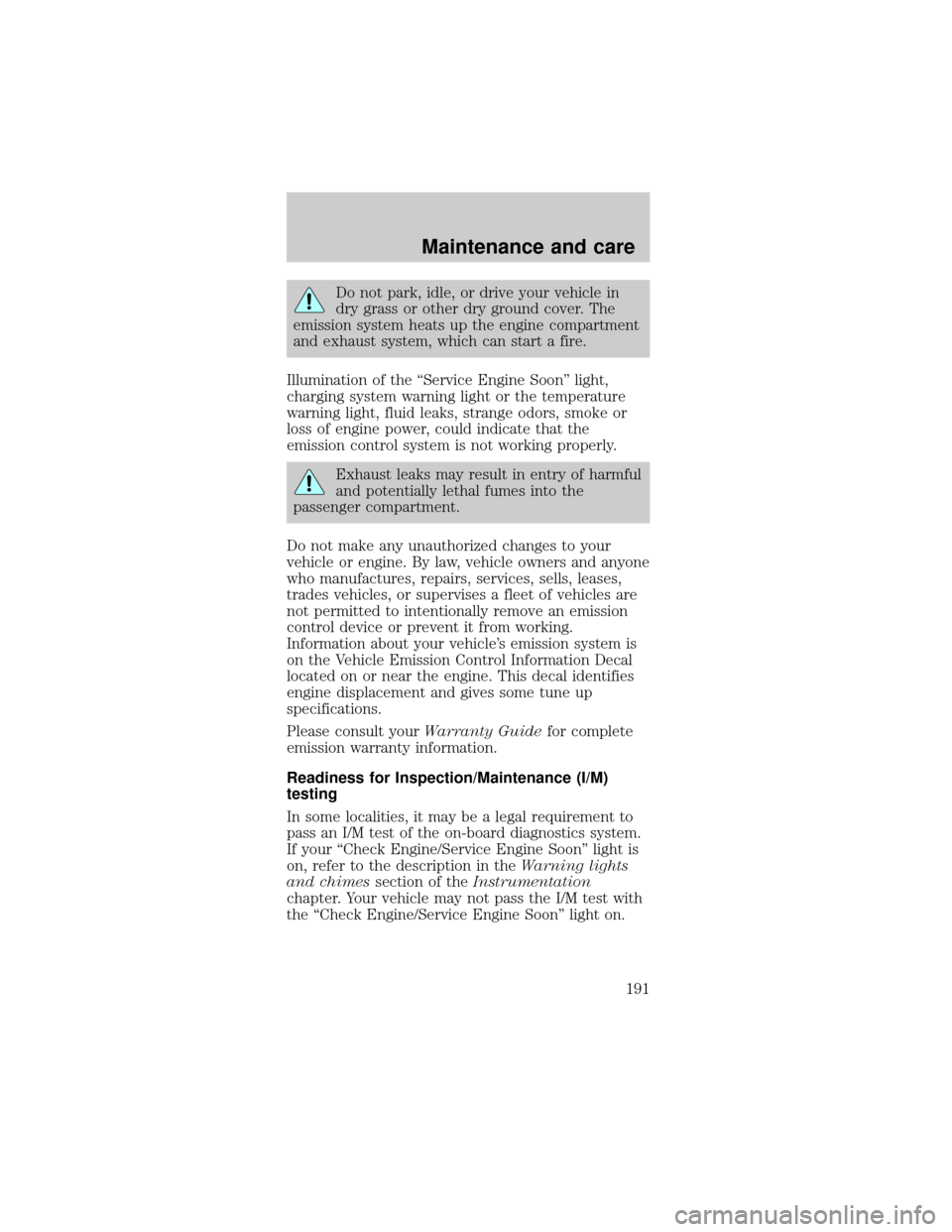
Do not park, idle, or drive your vehicle in
dry grass or other dry ground cover. The
emission system heats up the engine compartment
and exhaust system, which can start a fire.
Illumination of the ªService Engine Soonº light,
charging system warning light or the temperature
warning light, fluid leaks, strange odors, smoke or
loss of engine power, could indicate that the
emission control system is not working properly.
Exhaust leaks may result in entry of harmful
and potentially lethal fumes into the
passenger compartment.
Do not make any unauthorized changes to your
vehicle or engine. By law, vehicle owners and anyone
who manufactures, repairs, services, sells, leases,
trades vehicles, or supervises a fleet of vehicles are
not permitted to intentionally remove an emission
control device or prevent it from working.
Information about your vehicle's emission system is
on the Vehicle Emission Control Information Decal
located on or near the engine. This decal identifies
engine displacement and gives some tune up
specifications.
Please consult yourWarranty Guidefor complete
emission warranty information.
Readiness for Inspection/Maintenance (I/M)
testing
In some localities, it may be a legal requirement to
pass an I/M test of the on-board diagnostics system.
If your ªCheck Engine/Service Engine Soonº light is
on, refer to the description in theWarning lights
and chimessection of theInstrumentation
chapter. Your vehicle may not pass the I/M test with
the ªCheck Engine/Service Engine Soonº light on.
Maintenance and care
191
Page 192 of 240

If the vehicle's powertrain system or its battery has
just been serviced, the on-board diagnostics system
is reset to a ªnot ready for I/M testº condition. To
ready the on-board diagnostics system for I/M
testing, a minimum of 30 minutes of city and
highway driving is necessary as described below:
²First, at least 10 minutes of driving on an
expressway or highway.
²Next, at least 20 minutes driving in stop-and-go,
city-type traffic with at least four idle periods.
Allow the vehicle to sit for at least eight hours
without starting the engine. Then, start the engine
and complete the above driving cycle. The engine
must warm up to its normal operating temperature.
Once started, do not turn off the engine until the
above driving cycle is complete.
BULBS
Replacing exterior bulbs
Check the operation of the following lamps
frequently:
²Headlamps
²Tail lamps
²Brakelamps
²High-mount brakelamp
²Turn signals
²Backup lamps
²License plate lamp
Do not remove lamp bulbs unless they will be
replaced immediately. If a bulb is removed for an
extended period of time, contaminants may enter
the lamp housings and affect performance.
Maintenance and care
192
Page 193 of 240

Replacing headlamp bulbs
To remove the headlamp bulb:
1. Make sure headlamp switch is in OFF position,
then open the hood.
2. At the back of the
headlamp, pull two
retainer pins up to
release the headlamp
assembly.
3. Pull headlamp
assembly forward
disengaging the lamp
from the rear hidden snap retainers to expose the
back of the bulb.
4. Disconnect the
electrical connector
from the bulb by
pulling rearward.
5. Remove the bulb
retaining ring by
rotating it
counterclockwise
(when viewed from the
rear) to free it from
the bulb socket, and slide the ring off the plastic
base. Keep the ring to retain the new bulb.
6. Without turning,
remove the old bulb
from the lamp
assembly by gently
pulling it straight out of
the lamp assembly.
Maintenance and care
193
Page 194 of 240
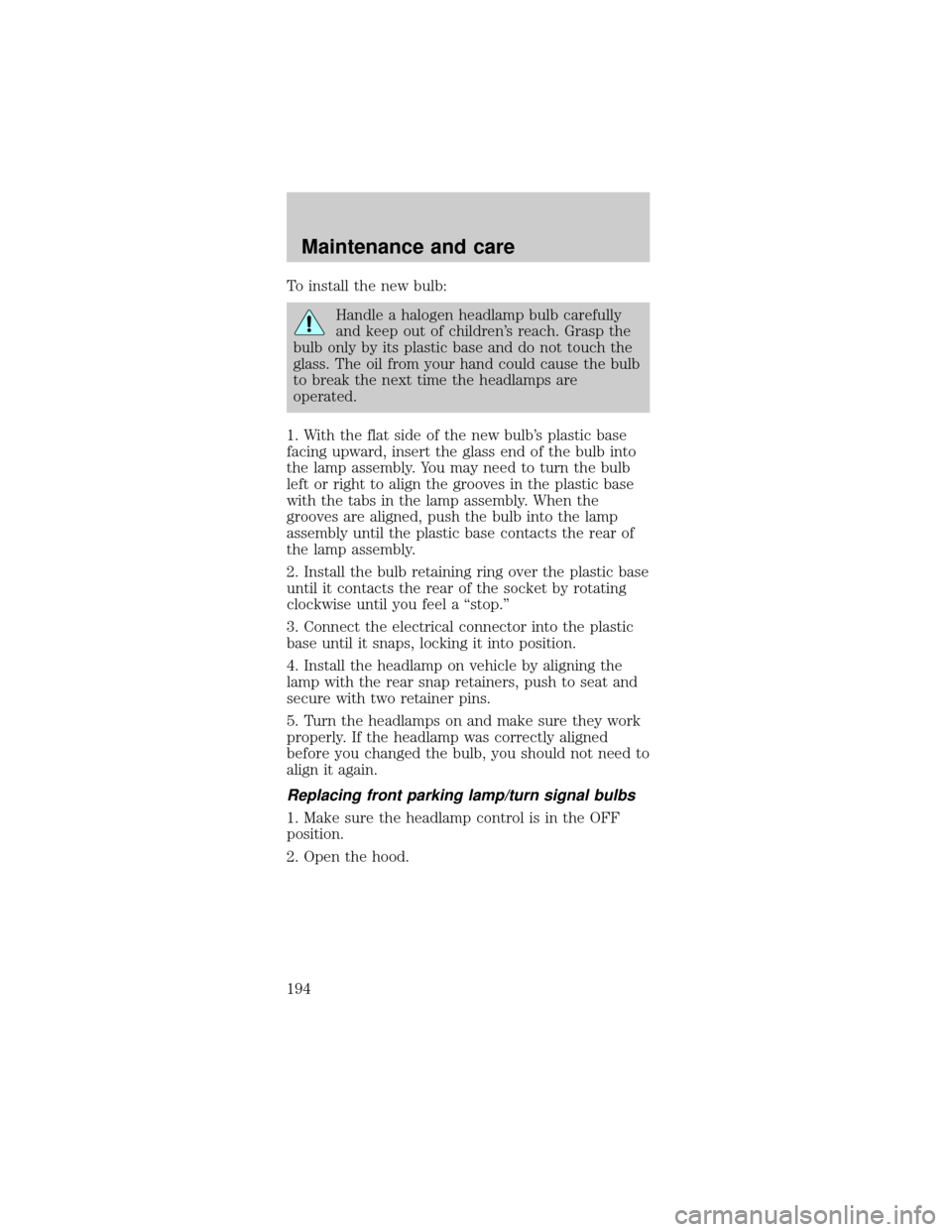
To install the new bulb:
Handle a halogen headlamp bulb carefully
and keep out of children's reach. Grasp the
bulb only by its plastic base and do not touch the
glass. The oil from your hand could cause the bulb
to break the next time the headlamps are
operated.
1. With the flat side of the new bulb's plastic base
facing upward, insert the glass end of the bulb into
the lamp assembly. You may need to turn the bulb
left or right to align the grooves in the plastic base
with the tabs in the lamp assembly. When the
grooves are aligned, push the bulb into the lamp
assembly until the plastic base contacts the rear of
the lamp assembly.
2. Install the bulb retaining ring over the plastic base
until it contacts the rear of the socket by rotating
clockwise until you feel a ªstop.º
3. Connect the electrical connector into the plastic
base until it snaps, locking it into position.
4. Install the headlamp on vehicle by aligning the
lamp with the rear snap retainers, push to seat and
secure with two retainer pins.
5. Turn the headlamps on and make sure they work
properly. If the headlamp was correctly aligned
before you changed the bulb, you should not need to
align it again.
Replacing front parking lamp/turn signal bulbs
1. Make sure the headlamp control is in the OFF
position.
2. Open the hood.
Maintenance and care
194
Page 195 of 240
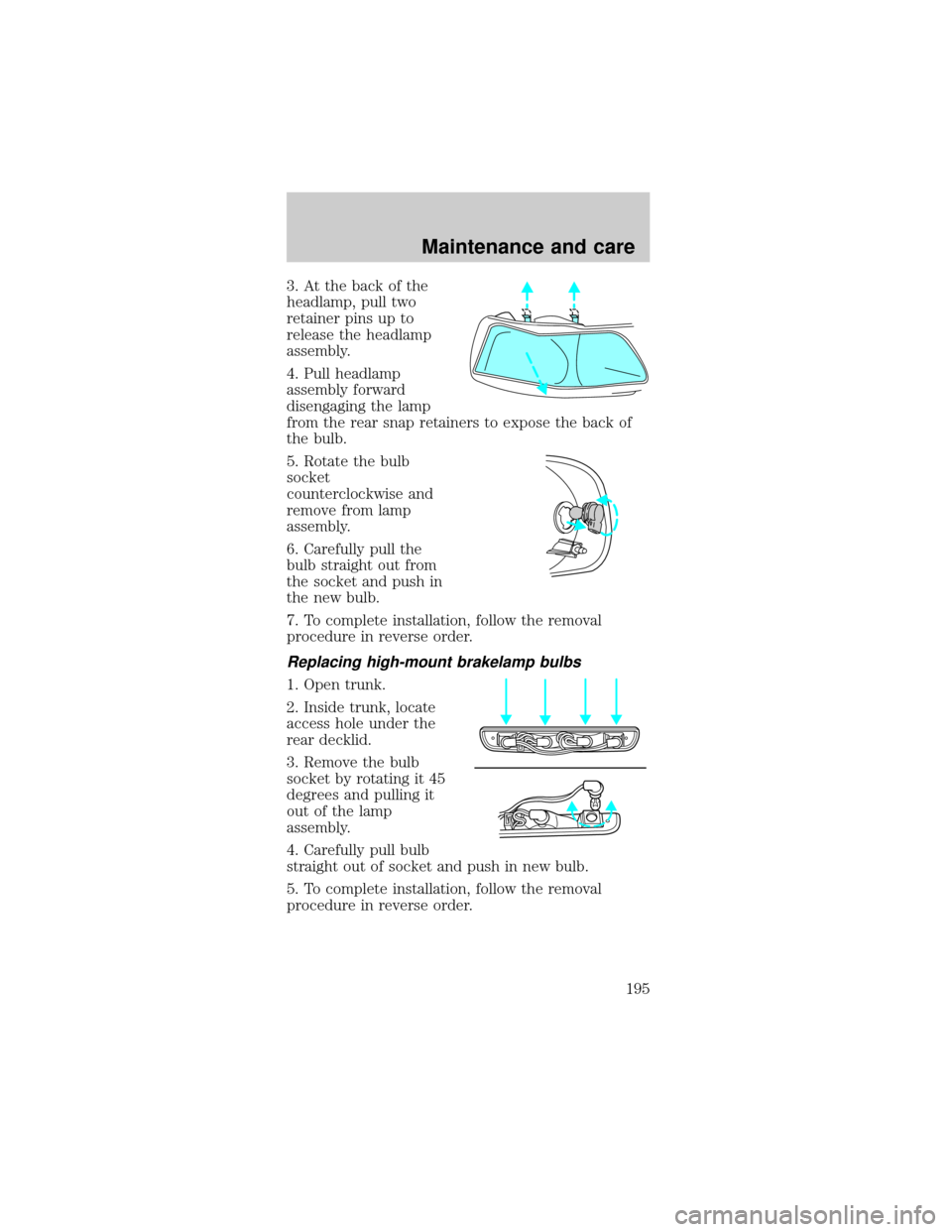
3. At the back of the
headlamp, pull two
retainer pins up to
release the headlamp
assembly.
4. Pull headlamp
assembly forward
disengaging the lamp
from the rear snap retainers to expose the back of
the bulb.
5. Rotate the bulb
socket
counterclockwise and
remove from lamp
assembly.
6. Carefully pull the
bulb straight out from
the socket and push in
the new bulb.
7. To complete installation, follow the removal
procedure in reverse order.
Replacing high-mount brakelamp bulbs
1. Open trunk.
2. Inside trunk, locate
access hole under the
rear decklid.
3. Remove the bulb
socket by rotating it 45
degrees and pulling it
out of the lamp
assembly.
4. Carefully pull bulb
straight out of socket and push in new bulb.
5. To complete installation, follow the removal
procedure in reverse order.
Maintenance and care
195
Page 196 of 240
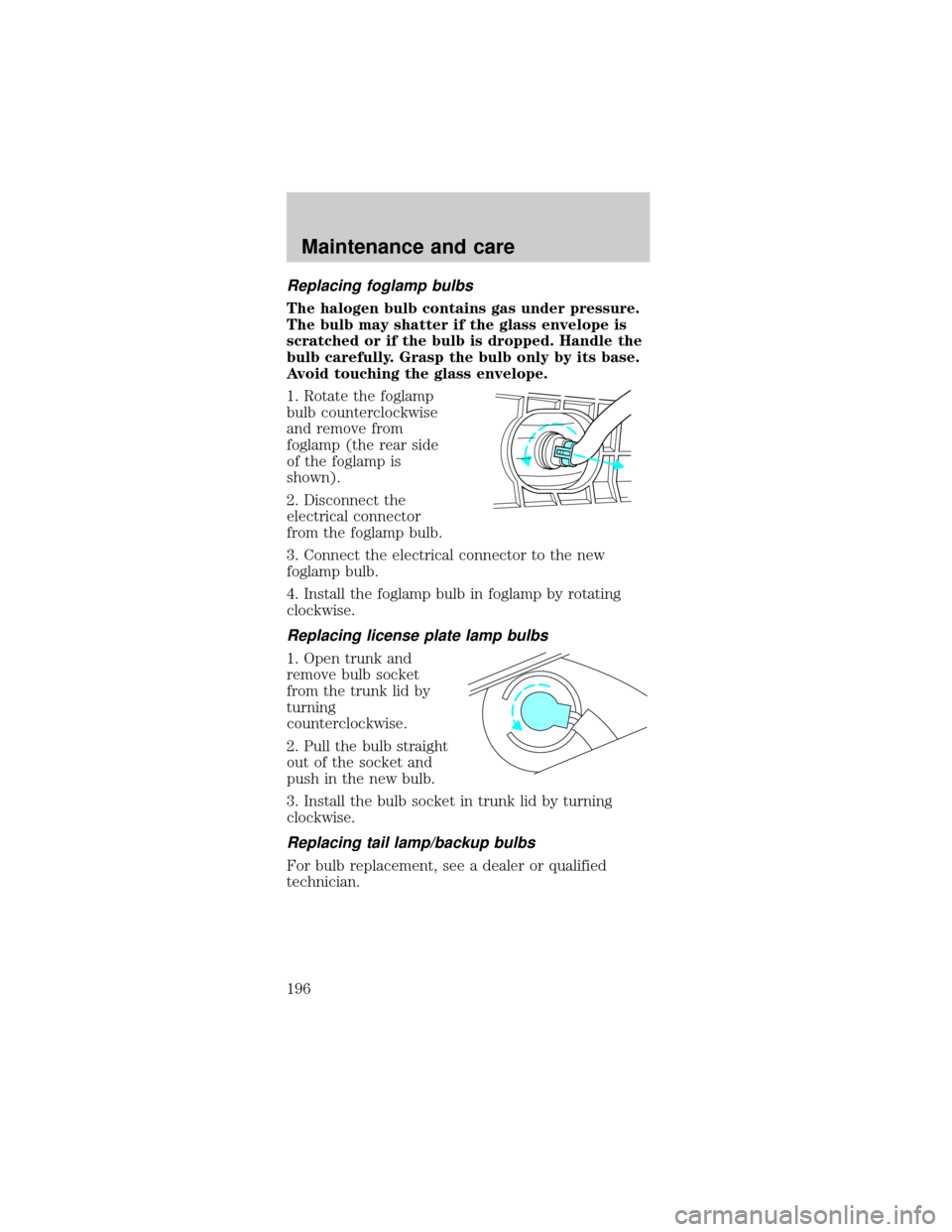
Replacing foglamp bulbs
The halogen bulb contains gas under pressure.
The bulb may shatter if the glass envelope is
scratched or if the bulb is dropped. Handle the
bulb carefully. Grasp the bulb only by its base.
Avoid touching the glass envelope.
1. Rotate the foglamp
bulb counterclockwise
and remove from
foglamp (the rear side
of the foglamp is
shown).
2. Disconnect the
electrical connector
from the foglamp bulb.
3. Connect the electrical connector to the new
foglamp bulb.
4. Install the foglamp bulb in foglamp by rotating
clockwise.
Replacing license plate lamp bulbs
1. Open trunk and
remove bulb socket
from the trunk lid by
turning
counterclockwise.
2. Pull the bulb straight
out of the socket and
push in the new bulb.
3. Install the bulb socket in trunk lid by turning
clockwise.
Replacing tail lamp/backup bulbs
For bulb replacement, see a dealer or qualified
technician.
Maintenance and care
196
Page 197 of 240
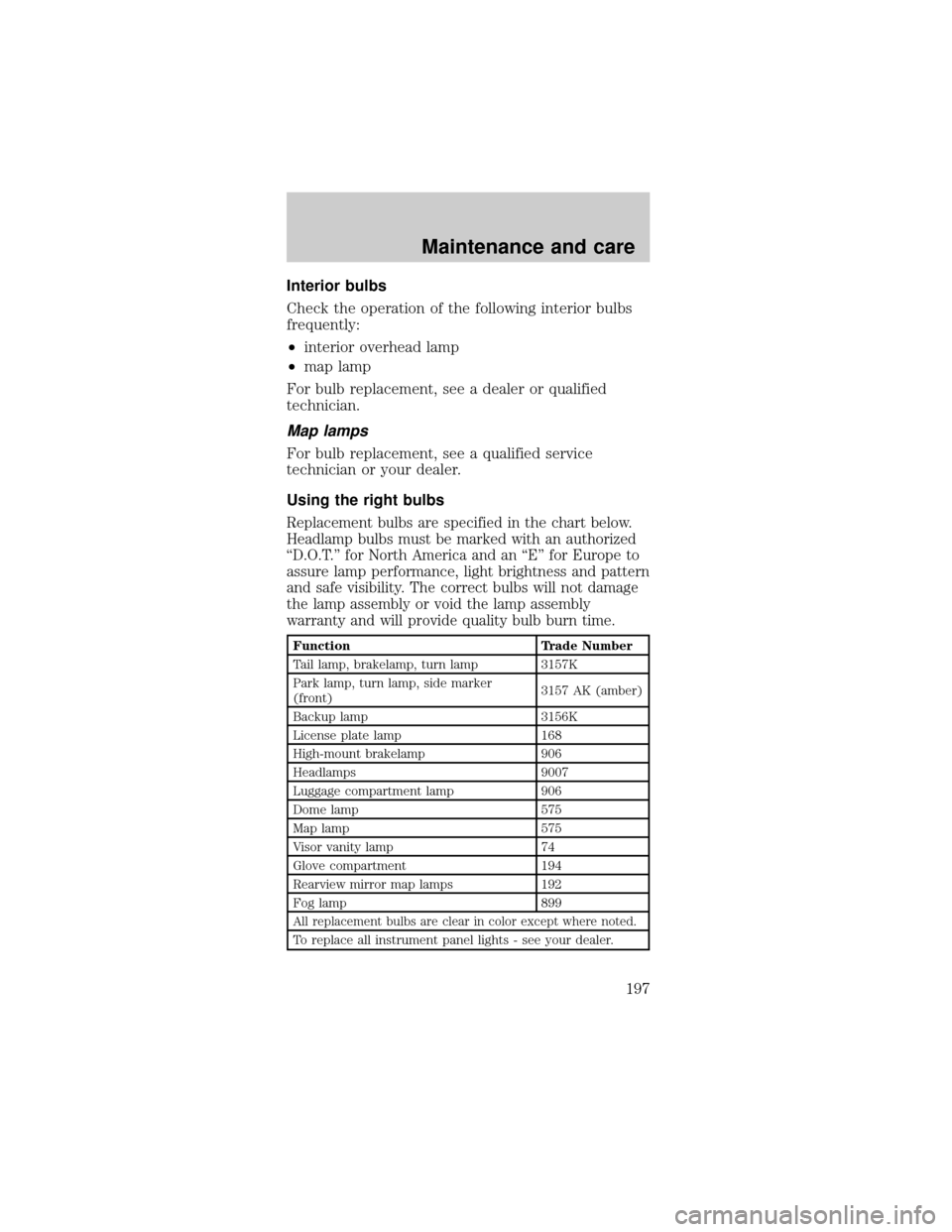
Interior bulbs
Check the operation of the following interior bulbs
frequently:
²interior overhead lamp
²map lamp
For bulb replacement, see a dealer or qualified
technician.
Map lamps
For bulb replacement, see a qualified service
technician or your dealer.
Using the right bulbs
Replacement bulbs are specified in the chart below.
Headlamp bulbs must be marked with an authorized
ªD.O.T.º for North America and an ªEº for Europe to
assure lamp performance, light brightness and pattern
and safe visibility. The correct bulbs will not damage
the lamp assembly or void the lamp assembly
warranty and will provide quality bulb burn time.
Function Trade Number
Tail lamp, brakelamp, turn lamp 3157K
Park lamp, turn lamp, side marker
(front)3157 AK (amber)
Backup lamp 3156K
License plate lamp 168
High-mount brakelamp 906
Headlamps 9007
Luggage compartment lamp 906
Dome lamp 575
Map lamp 575
Visor vanity lamp 74
Glove compartment 194
Rearview mirror map lamps 192
Fog lamp 899
All replacement bulbs are clear in color except where noted.
To replace all instrument panel lights - see your dealer.
Maintenance and care
197
Page 198 of 240
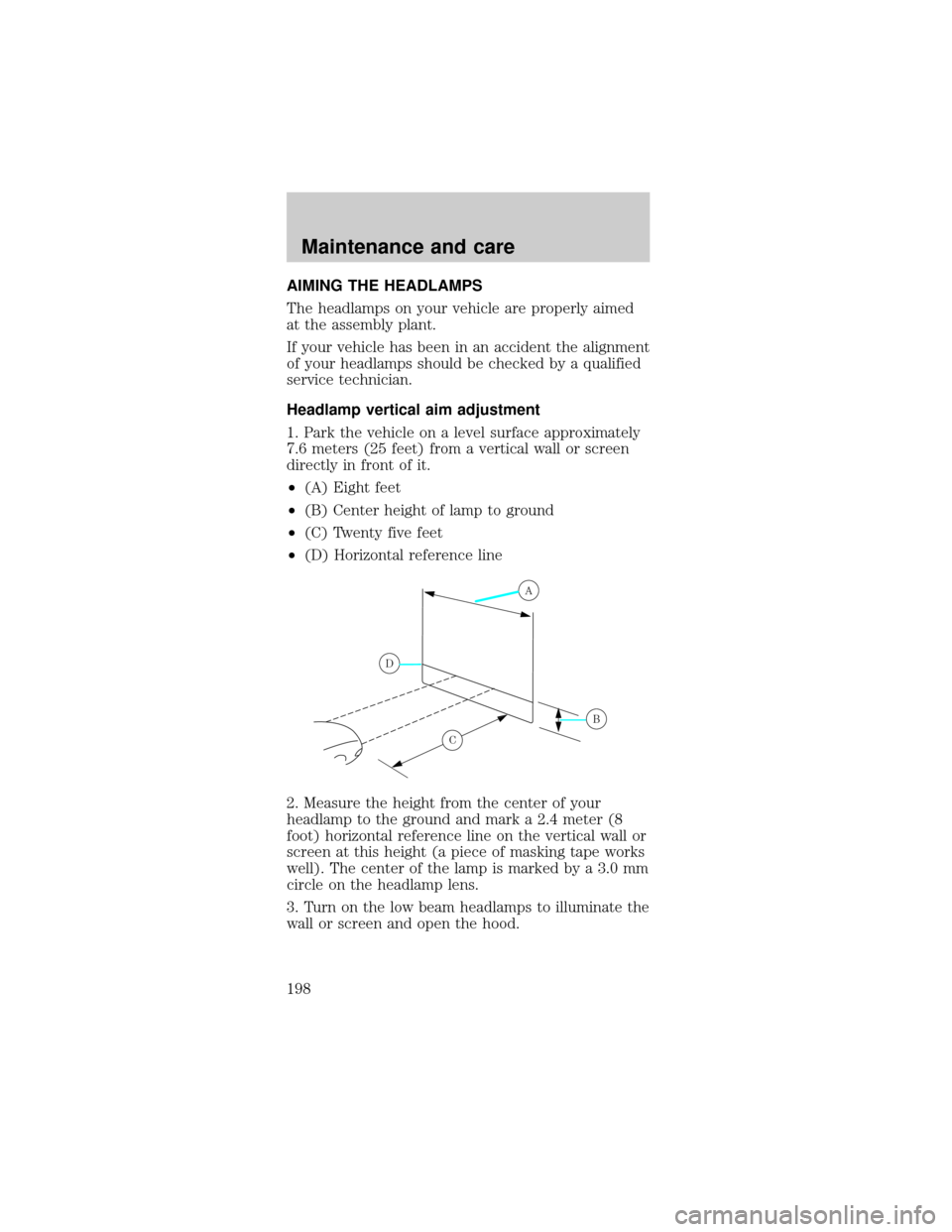
AIMING THE HEADLAMPS
The headlamps on your vehicle are properly aimed
at the assembly plant.
If your vehicle has been in an accident the alignment
of your headlamps should be checked by a qualified
service technician.
Headlamp vertical aim adjustment
1. Park the vehicle on a level surface approximately
7.6 meters (25 feet) from a vertical wall or screen
directly in front of it.
²(A) Eight feet
²(B) Center height of lamp to ground
²(C) Twenty five feet
²(D) Horizontal reference line
2. Measure the height from the center of your
headlamp to the ground and mark a 2.4 meter (8
foot) horizontal reference line on the vertical wall or
screen at this height (a piece of masking tape works
well). The center of the lamp is marked by a 3.0 mm
circle on the headlamp lens.
3. Turn on the low beam headlamps to illuminate the
wall or screen and open the hood.
A
D
B
C
Maintenance and care
198
Page 199 of 240
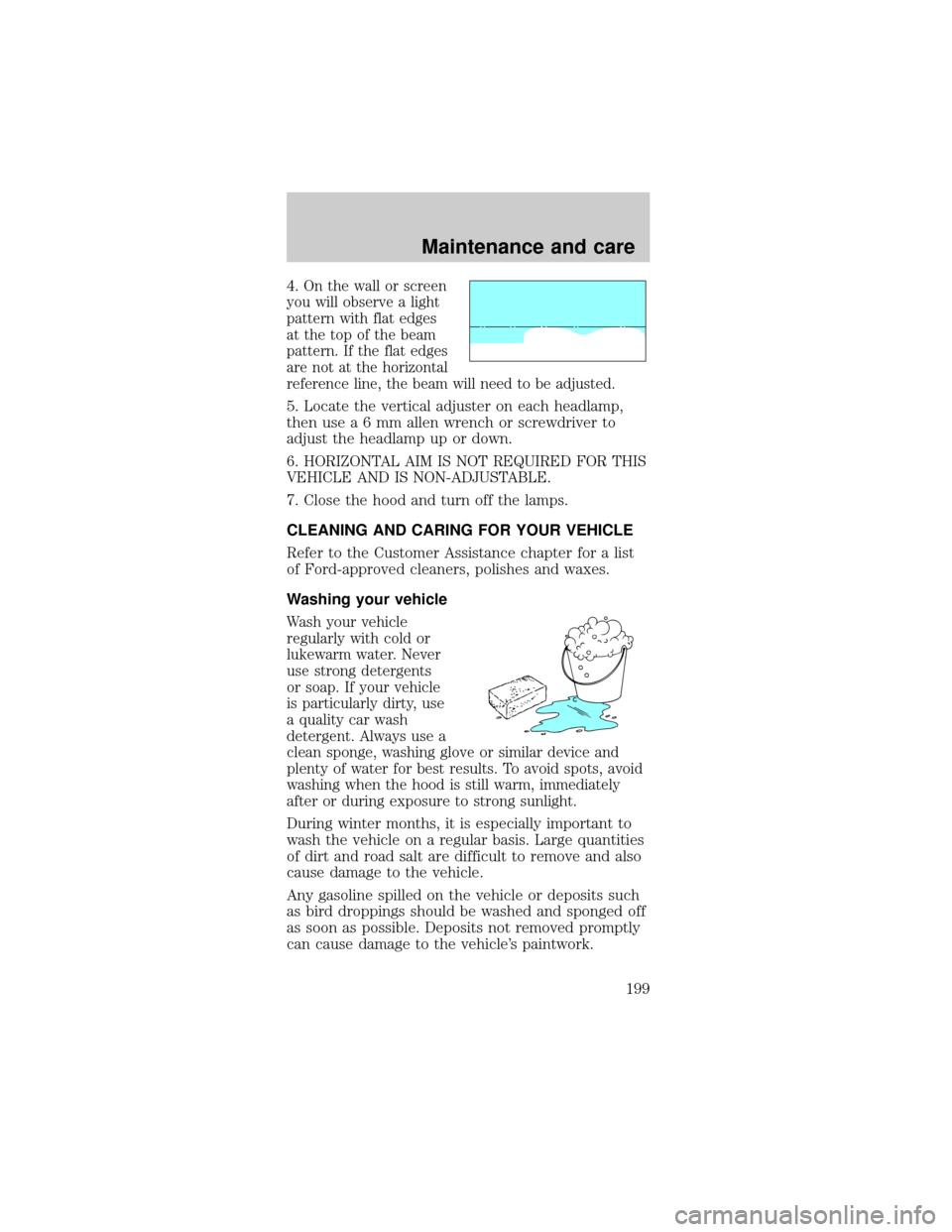
4.On the wall or screen
you will observe a light
pattern with flat edges
at the top of the beam
pattern. If the flat edges
are not at the horizontal
reference line, the beam will need to be adjusted.
5. Locate the vertical adjuster on each headlamp,
then usea6mmallen wrench or screwdriver to
adjust the headlamp up or down.
6. HORIZONTAL AIM IS NOT REQUIRED FOR THIS
VEHICLE AND IS NON-ADJUSTABLE.
7. Close the hood and turn off the lamps.
CLEANING AND CARING FOR YOUR VEHICLE
Refer to the Customer Assistance chapter for a list
of Ford-approved cleaners, polishes and waxes.
Washing your vehicle
Wash your vehicle
regularly with cold or
lukewarm water. Never
use strong detergents
or soap. If your vehicle
is particularly dirty, use
a quality car wash
detergent. Always use a
clean sponge, washing glove or similar device and
plenty of water for best results. To avoid spots, avoid
washing when the hood is still warm, immediately
after or during exposure to strong sunlight.
During winter months, it is especially important to
wash the vehicle on a regular basis. Large quantities
of dirt and road salt are difficult to remove and also
cause damage to the vehicle.
Any gasoline spilled on the vehicle or deposits such
as bird droppings should be washed and sponged off
as soon as possible. Deposits not removed promptly
can cause damage to the vehicle's paintwork.
Maintenance and care
199
Page 200 of 240

Remove any exterior accessories, such as antennas,
before entering a car wash. If you have wax applied
to the vehicle at a commercial car wash, it is
recommended that you clean the wiper blades and
windshield as described inCleaning the wiper
blades and windshield.
After washing, apply the brakes several times to dry
them.
Underbody
Flush the complete underside of vehicle frequently.
Keep body drain holes unplugged. Inspect for road
damage.
Waxing your vehicle
Waxing your vehicle on a regular basis will reduce
minor scratches and paint damage.
Wax when water stops beading on the surface. This
could be every three or four months, depending on
operating conditions.
Use only carnauba or synthetic-based waxes. Use a
cleaning fluid with a clean cloth to remove any bugs
before waxing your vehicle. Use tar remover to
remove any tar spots.
Avoid getting wax on the windshield, or on any
surfaces which appear coarse or bumpy. If you have
wax applied at a commercial car wash, it is
recommended that you clean the wiper blades and
windshield as described inCleaning the wiper
blades and windshield.
Repairing paint chips
Minor scratches or paint damage from road debris
may be repaired with the Ultra Touch Prep and
Finishing Kit (F7AZ-19K507±BA), Lacquer Touch-up
Paint (ALBZ-19500±XXXXA), or Exterior Acrylic
Spray Lacquer (ALAZ-19500±XXXXA) from the Ford
Car Care Chemicals line. Please note that the part
numbers (shown as XXXX above) will vary with your
vehicle's specific coloring. Observe the application
instructions on the products.
Maintenance and care
200